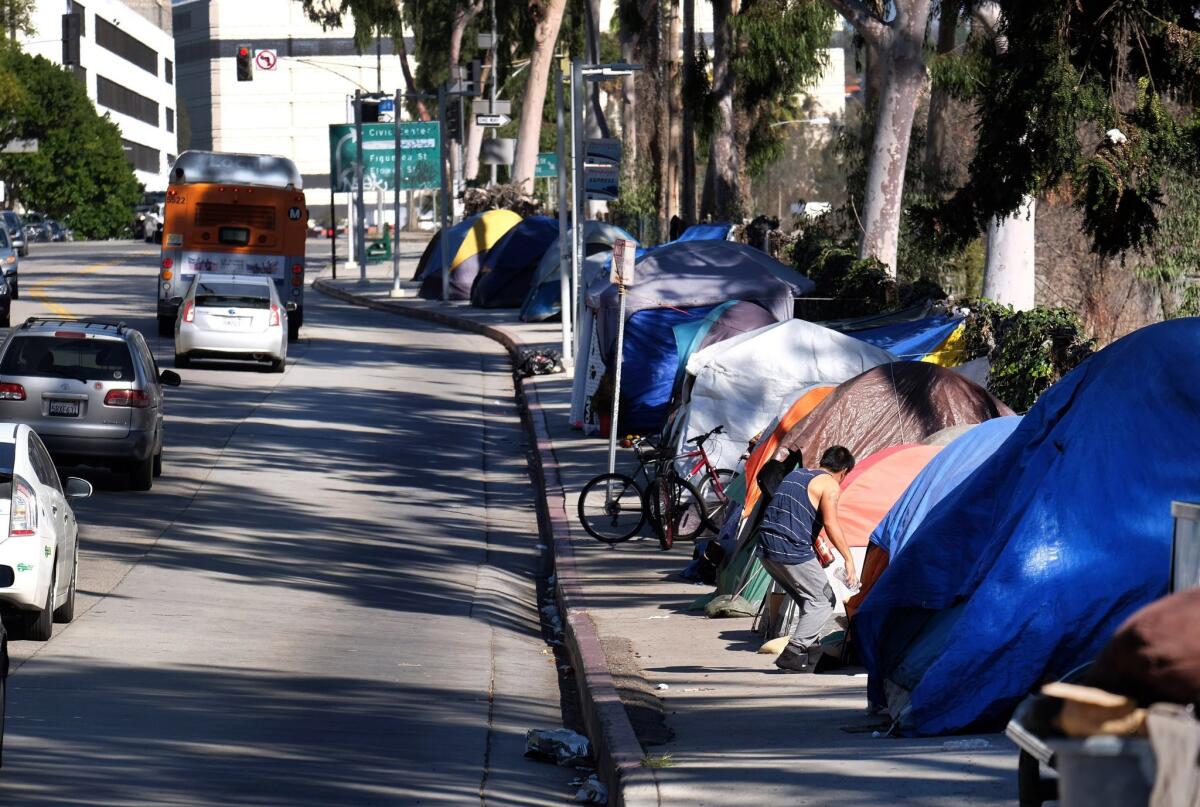Editorial: L.A. finally passes a unified plan to help the homeless – now the hard part begins

- Share via
On Tuesday, both the county and the city of Los Angeles approved far-reaching and ambitious plans to help homeless people off the streets through a combination of housing, rental subsidies, case management and expanded counseling, therapy and other services. This is not the first time the county and the city have tried to address the problem of homelessness. But this time, they vow, they will succeed.
County and city elected officials say that unlike in the past they are now coordinating their plans rather than working at loggerheads, and that they have a level of political will and fortitude that they never had before. “Urgency has to be the mantra of the day,” said county Supervisor Mark Ridley-Thomas.
Let’s hope they mean it. The number of homeless in the county rose 12% from 2013 to 2015, to about 44,000 people; they are now found in every council and supervisorial district. This should be an issue of top-level concern to elected officials if only because it is of concern to their constituents, at a level, we suspect, that it has not been in recent years.
But past efforts to address the problem have repeatedly stumbled, as officials came face-to-face with resistance from neighborhoods to housing formerly homeless people in their midst, and to constructing new buildings to accommodate them. Officials have gotten in each other’s way because of competing politics, ideology and personality. They have had trouble consistently maintaining the necessary attention as other problems have arisen and homelessness has receded. They have disagreed over the proper prescription for dealing with the problem, and even over what the problem is — too many untreated mentally ill people, for example, or too much poverty? And always, they have had an enormous financial challenge: Where will they get enough money to build the housing and provide the services for tens of thousands of people?
This time, the city and county plans have many appealing elements. Each lays out numerous recommendations but wisely flags about a dozen that could be started quickly — generally by the end of June. For example, the county and the city say they will commit millions of dollars to housing vouchers and rental subsidies for homeless people — funding that can get a homeless person off the street quickly or catch people before they fall into homelessness. Another proposal that they ought to undertake quickly involves the many people in county jails, hospitals and foster care who are vulnerable to becoming homeless upon release. The county plan recommends that there be case management provided to them long before they are released.
Paying for all these programs could require voters to approve new taxes or bond measures. Will politicians have the audacity to ask for that? Will voters agree?
No one is going to house all homeless people in the county in the space of a year or two. Permanent supportive housing — which is necessary for the most chronically homeless people with mental or physical disabilities — is costly and difficult to build. In the short term, it’s imperative that the county and the city quickly make available more housing subsidies to get homeless people into existing units. Then the city has to find ways to jump-start the building process. The city, for example, has creative and enterprising plans to look into building housing on city-owned land or other public property as well as securing air rights over city-owned parking lots for housing. Officials also want to look into using micro-unit apartments for permanent supportive housing.
A key problem, as in the past, will be finding the money needed to pay for it all. The county had already approved $105.7 million in funding for the homeless initiative, and on Tuesday it approved $44 million more. That’s a generous start, but the supervisors acknowledged there will have to be even more funding down the road. The plan estimates that its programs will result in 3,500 homeless people being housed — and an additional 2,000 kept from becoming homeless — by June 30, 2017.
City Council members want $100 million set aside in the fiscal year 2016-2017 budget for homelessness programs. Mayor Eric Garcetti is expected to propose that. The council needs to make sure those funds are not dropped from the budget. But that’s just a fraction of what they need; over the coming decade, the city’s plan would cost $1.85 billion in estimated spending on housing alone.
Paying for all these programs could require voters to approve new taxes or bond measures. Will politicians have the audacity to ask for that? Will voters agree?
An enormous amount of time and thought has been put into these plans. They have the support of many nonprofits and advocates for the homeless (though not all). But the really hard work lies ahead. Now it’s time for elected officials to act on their promises, to use their political capital even if it means facing down resistance from their constituents. If they can do that, they will be on their way to reducing homelessness and perhaps, someday, eliminating it.
Follow the Opinion section on Twitter @latimesopinion and Facebook
More to Read
A cure for the common opinion
Get thought-provoking perspectives with our weekly newsletter.
You may occasionally receive promotional content from the Los Angeles Times.









